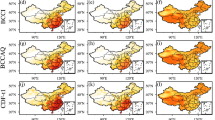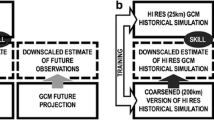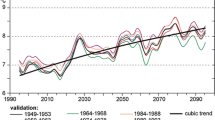Abstract
Statistical downscaling methods are commonly used to address the scale mismatch between coarse resolution Global Climate Model output and the regional or local scales required for climate change impact assessments. The effectiveness of a downscaling method can be measured against four broad criteria: consistency with the existing baseline data in terms of means, trends and distributional characteristics; consistency with the broader scale climate data used to generate the projections; the degree of transparency and repeatability; and the plausibility of results produced. Many existing downscaling methods fail to fulfil all of these criteria. In this paper we examine a block bootstrap simulation technique combined with a quantile prediction and matching method for simulating future daily climate data. By utilising this method the distributional properties of the projected data will be influenced by the distribution of the observed data, the trends in predictors derived from the Global Climate Models and the relationship of these predictors to the observed data. Using observed data from several climate stations in Vanuatu and Fiji and out-of-sample validation techniques, we show that the method is successful at projecting various climate characteristics including the variability and auto-correlation of daily temperature and rainfall, the correlations between these variables and between spatial locations. This paper also illustrates how this novel method can produce more effective point scale projections and a more credible alternative to other approaches in the Pacific region.








Similar content being viewed by others
Notes
Assuming zero correlation between the estimated coverage rates which leads to a conservative test of the difference.
References
Australian Bureau of Meteorology and CSIRO (2011) Climate change in the Pacific: scientific assessment and new research. Volume 1: Regional overview. Volume 2: Country reports. http://www.cawcr.gov.au/projects/PCCSP/publications.html
Banjaree S, Carlin BP, Gelfand AE (2004) Hierarchical modeling and analysis for spatial data. Chapman-Hall CRC Press, Boca Raton
Charles SP, Bates BC, Smith IN, Hughes JP (2004) Statistical downscaling of daily precipitation from observed and modelled atmospheric fields. Hydrol Process 18:1373–1394
DelSole T, Shukla J (2009) Artificial skill due to predictor screening. J Clim 22:331–345
Dessai S, Hulme M (2007) Assessing the robustness of adaptation decisions to climate change uncertainties: a case-study on water resources management in the East of England. Glob Environ Chang 17:59–72
Efron B (1982) The jackknife, the bootstrap, and other resampling plans. Society for Industrial and Applied Mathematical, Philadelphia
Enke W, Spekat A (1997) Downscaling climate model outputs into local and regional weather elements by classification and regression. Clim Res 8:195–207
Fowler HJ, Blenkinsop S, Tebaldi C (2007) Linking climate change modelling to impacts studies: recent advances in downscaling techniques for hydrological modelling. Int J Clim 27:1547–1578
Frost AJ, Charles SP, Timbal B, Chiew FH, Mehrotra R, Nguyen KC, Chandler RE, McGregor JL, Fu G, Kirono DG, Fernandez E, Kent DM (2011) A comparison of multi-site daily rainfall downscaling techniques under Australian conditions. J Hydrol 408:1–18
Füssel HM (2007) Vulnerability: a generally applicable conceptual framework for climate change research. Glob Environ Chang 17:155–167
Gagnon-Lebrun F, Agrawala S (2006) Progress on adaptation to climate change in developed countries: an analysis of broad trends. Tech. rep., Paris: Organization for Economic Cooperation and Development, eNV/EPOC/GSP(2006)1/FINAL
Goyal MK, Ojha CSP (2010) Evaluation of various linear regression methods for downscaling of mean monthly precipitation in the arid Pichola watershed. Nat Resour 1:11–18
Hammer G, Holzworth D, Stone R (1996) The value of skill in seasonal climate forecasting to wheat crop management in a region with high climatic variability. Aust J Agricult Res 47:717–737
Hulme M, Dessai S (2008) Predicting, deciding, learning: can one evaluate the success of national climate scenarios? Environ Res Lett 3 (October–December 2008). doi:10.1088/1748-9326/3/4/045013
Hutchinson MF (1995) Interpolating mean rainfall using thin plate smoothing splines. Int J Geogr Inform Syst 9:385–403
Kunsch H (1989) The jackknife and the bootstrap for general stationary observations. Ann Stat 17:1217–1241
Li Y, Smith I (2009) A statistical downscaling model for southern Australia winter rainfall. J Clim 22:1142–1158
Li H, Sheffield J, Wood E (2010) Bias correction of monthly precipitation and temperature fields from Intergovernmental Panel on Climate Change AR4 models using equidistant quantile matching. J Geophys Res 115(D10):D10,101
McGregor JL, Dix MR (2008) An updated description of the Conformal-Cubic Atmospheric Model. In: Hamilton K, Ohfuchi W (eds) High resolution simulation of the atmosphere and ocean. Springer, New York, pp 51–76
Møller B, Weedon-Fekær H, Haldorsen T (2005) Empirical evaluation of prediction intervals for cancer incidence. BMC Med Res Methodol 5. doi:10.1186/1471-2288-5-21
Schwarz G (1978) Estimating the dimension of a model. Ann Stat 5:461–464
Semenov MA, Brooks RJ, Barrow EM, Richardson CW (1998) Comparison of the wgen and lars-wg stochastic weather generators for diverse climates. Clim Res 10:95–107
Smith I, Chiew F (2009) Document and assess methods for generating inputs to hydrological models and extend delivery of projections across Victoria. Final project report 2.2.5B, CSIRO, http://www.seaci.org/research/documents/S1_FR225P.pdf
Timbal B, Jones DA (2008) Future projections of winter rainfall in southeast Australia using a statistical downscaling technique. Clim Chang 86:165–187
Wallis TW, Griffiths JF (1997) Simulated meteorological input for agricultural models. Agricult For Meteorol 88(1–4):241–258. doi:10.1016/S0168-1923(97)00035-X, http://www.sciencedirect.com/science/article/pii/S016819239700035X
Wood AW, Leung LR, Sridhar V, Lettenmaier DP (2004) Hydrologic implications of dynamical and statistical approaches to downscaling climate model outputs. Clim Chang 62:189–216. doi:10.1023/B:CLIM.0000013685.99609.9e
Acknowledgments
The authors are grateful to the anonymous reviewers for their constructive comments. They would also like to acknowledge the advice provided by Mark Howden of CSIRO, thank JinYoung Lee and JaeEun Chang for their programming assistance, and Garry Hopwood of CSIRO for his comments. This work was financially supported by the Australian Centre for International Agricultural Research, and the Pacific Climate Change Science Program managed by AusAID and the Australian Department of Climate Change and Energy Efficiency.
Author information
Authors and Affiliations
Corresponding author
Appendix: The quantile matching functions for rainfall
Appendix: The quantile matching functions for rainfall
A dry day is defined as any day with less than θmin (>0) mm of rainfall. Often θmin = 1 mm/day. This is to exclude small amounts of precipitation that may occur as dew or frost. We know the empirical CDF of rainfall, \({F}_{m_b}\), the projected and fitted quantiles and dry-day proportions \(\hat{p}_{m_f}\), and the minimum precipitation threshold. Based on these data, we wish to construct a mapping so that we can predict the future CDF of rainfall, \(\hat{F}_{m_f}.\) The mappings we use are called the quantile matching functions.
Now we have estimates of the qth conditional quantiles of the future CDF:
These values are mapped from the three values in the base period:
respectively. These values were chosen as they have the same quantile levels in the base month as \(\hat{\theta}_{m_f}(q), \quad q=0.1,0.5,0.9\), has in the future month (Fig. 9). This is what is done in Fig. 1 for the special case of a continuous variable where \(\hat{p}_{m_f} = 0\). For rainfall, however, there is a discontinuity in the distribution function at zero which needs to be removed when constructing the quantile matching function. This is achieved by setting:
and then using linear interpolation in between these values as shown in Fig. 9. Since θmin is the minimum observable rainfall, making such a change has no effect on the distribution of data, but it is important for the simulation of data. The quantile values corresponding to these in the base month are:
The five values given in expressions (2–5) are used to construct the quantile matching function (Fig. 10a). We use linear interpolation to approximate quantiles in between these values, and beyond the 0.9 quantile we use the 45° line to extrapolate the extreme quantiles. The rest of the future CDF shown in Fig. 9 is then constructed from the quantile matching function. The quantile matching function is used to project a rainfall value, Y t , in the base month to a corresponding value, \(Y_{{tm}_{f}}\), in the future month (Fig. 10). If, however, Y t = 0, it is replaced by a random value between 0 and θmin before it is projected. This allows for the possibility that \(\hat{p}_{m_f} < p_{m_b}\) in which case some days that are dry in the base period will become rain days when projected.
Quantile matching functions for rainfall. These functions map the empirical distribution of the observed data in a base-period month to either a the projected distribution, or b the fitted distribution for the same month. Note that \(Q_{m_b}(q) \equiv F_{m_b}^{-1}\left(\hat{p}_{m_f}+(1-\hat{p}_{m_f})q\right)\). If Y t = 0 its value is replaced by a random value from the grey region prior to mapping
An analogous procedure is used to determine \(Y_{{tm}_{f}}\), in the base month (Fig. 10b). Finally, the error corrected projected value of rainfall is:
Rights and permissions
About this article
Cite this article
Kokic, P., Jin, H. & Crimp, S. Improved point scale climate projections using a block bootstrap simulation and quantile matching method. Clim Dyn 41, 853–866 (2013). https://doi.org/10.1007/s00382-013-1791-z
Received:
Accepted:
Published:
Issue Date:
DOI: https://doi.org/10.1007/s00382-013-1791-z






